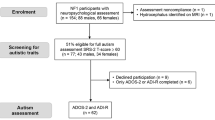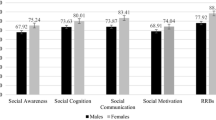Abstract
Six girls aged 6–10 years meeting criteria for autistic disorder are presented. They were all high-functioning in that they had IQs in the 60–100 range and spoke in complicated sentences. Their clinical picture had not led a variety of specialists to consider an autism diagnosis before age 6 years in spite of the fact that they had shown mild motor delays, uncharacteristic developmental deviance and social, communicative and imaginative deficits already before age 2 years in all cases. It is suggested that the autism phenotype might be different in girls as compared with boys. It is further speculated that if female cases such as those described — and others given a whole host of different diagnostic labels — were only considered for an autism diagnosis, the high male:female ratio traditionally encountered in autism might drop considerably.
Résumé
Six filles âgées de 6 à 10 ans présentant les critères d'un trouble autistique sont présentées. Elles avaient un bon niveau de fonctionnement avec un Q.I. entre 60 et 100 et parlaient un langage relativement sophistiqué. Le tableau clinique n'avait pas nécessité une grande variété de spécialistes pour que soit porté le diagnostic d'autisme avant l'âge de 6 ans, en dépit du fait qu'elles avaient montré des retards moteurs modérés, une anomalie développementale non caractéristique et des déficits relationnels et imaginatifs avant l'âge de 2 ans dans tous les cas. Il est suggéré que le phénotype de l'autisme pourrait être différent chez les filles et chez les garçons. Il est envisagé que si les cas féminins, tels que ceux envisagés et d'autres portant des labels diagnostiques différents étaient pris en compte pour un diagnostic d'autisme, le traditionnel ratio élevé masculin/féminin rencontré dans l'autisme pourrait chuter considérablement.
Zusammenfassung
Es werden sechs Mädchen im Alter von 6–10 Jahren vorgestellt, die die Kriterien für eine autistische Störung erfüllen. Sie wiesen ein relativ hohes funktionsniveau auf: alle zeigten IQ-Werte zwische 60 und 100 und sprachen komplexe Sätze. Obwohl sie leichte motorische Rückstände, uncharakteristische Entwicklungsabweichungen und soziale und kommunikative und eingeschränktes Vorstellungsvermögen bereits vor dem Alter von 2 Jahren in allen Fällen aufwiesen, war aufgrund des klinischen Bildes die Diagnose Autismus durch eine Anzahl von Spezialisten nichr vor dem Alter von 6 Jahren gestellt worden. Wir nehmen an, daß sich der Phänotyp Autismus bei Mädchen anders als bei Jungen im Vergleich zu Mädchen sich eher angleichen würden, wenn bei weiblichen Fällen, wie die von uns beschriebenen, die eine ganze Reihe von Diagnosen erhalten hatten, die Diagnose Autismus in Betracht gezogen würde.
Similar content being viewed by others
References
American Psychiatric Association (1980).Diagnostic and Statistical Manual of Mental Disorders. DSM-III. Third Edition. Washington, DC: APA.
American Psychiatric Association (1987).Diagmostic and Statistical Manual of Mental Disorders. DSM-III-R. Third edition revised. Washington, DC: APA.
Asperger, H. (1944). Die “Autistischen Psychopathen” im Kindesalter.Archiv für Psychiarie und Nervenkrankheiten, 117, 76–136.
Bolton, P. & Rutter, M. (1990). Genetic influences in autism.International Review of Psychiatry, 2, 67–80.
Coleman, M. & Gillberg, C. (1985).The Biology of the Autistic Syndromes. New York: Praeger.
Frith, U. (1989). Autism and “theory of mind”. In C. Gillberg (Ed.),Diagnosis and treatment of autism (pp. 33–52). New York: Plenum Press.
Gillberg, C. & Gillberg, I. C. (1989). Asperger syndrome. Some epidemiological considerations: a research note.Journal of Child Psychology and Psychiatry, 30, 631–638.
Gillberg, C & Râstam, M. (1992). Do some cases of anotexia nervosa reflect underlying autistic-like conditions?Behavioural Neurology (in press).
Gillberg, C. & Svennerholm, L. (1987). CSF-monoamines in autistic syndromes and other pervasive developmental disorders of early childhood.British Journal of Psychiatry, 151, 89–94.
Gillberg, C. (1989). Asperger syndrome in 23 Swedish children.Developmental Medicine and Child Neurology, 31, 520–531.
Gillberg, C., Schaumann, H. & Steffenburg, S., (1991). Is autism more common now than 10 years ago?British Journal of Psychiatry, 158, 403–409.
Kanner, L. (1943). Autistic disturbances of affective contact.Nervous Child, 2, 217–250.
Krug, D. A., Arick, J. & Almond, P. (1980). Autism Behavior Checklist for identifying severely handicapped individuals with high levels of autistic behavior.Journal of Child Psychology and Psychiatry,21, 221–229.
Lord, C. & Schopler, E. (1985). Differneces in sex ratios in autism as a function of measured intelligence.Journal of Autism and Developmental Disorders, 15, 185–193.
Lord, C., Schopler, E. & Revicki, D. (1982). Sex differences in autism.Journal of Autism and Developmental Disorders, 12, 317–330.
Maccoby, E. E. & Jacklin, C. N. (1980). Pschological sex diffrences. In M. Rutter (Ed.),Developmental Psychiatry. London: William Heinemann Medical Books.
Prior, M., Dahlstrom, B. & Squires, T. L. (1990). Autistic children's knowledge of thinking and feeling states in other people.Journal of Child Psychology and Psychiatry, 31, 587–601.
Rutter, M. (1978). Diagnosis and definition of childhood autism.Journal of Autism and Childhood Schizophrenia, 8, 139–161.
Rutter, M. (1985). Infantile autism and other pervasive developmental disorders. In M. Rutter & L. Hersov (Eds.),Child and Adolescent Psychiatry: Modern Approaches.2nd ed. (pp. 545–566). Oxford: Blackwell Scientific.
Schopler, E., Reichler, R. J., DeVellis, R. F. & Daly, K. (1980). Toward objective classification of childhood autism: Childhood Autism Rating Scale (CARS).Journal of Autism and Developmental Disonders, 10, 91–103.
Steffenburg, S. & Gillberg, C. (1986). Autism and autistic-like conditions in Swedish rural and urban areas: a population study.British Journal of Psychiatry, 149, 81–87.
Steffenburg, S. (1991): Neuropsychiatric assessment of children with autism: a population-based study.Developmental Medicine and Child Neurology, 33, 495–511.
Tsai, L., Stewart, M. A. & August, G. (1981). Implication of sex differences in the familial transmission of infantile autism.Journal of Autism and Developmental Disorders, 11, 165–173.
Waldrop, M. & Halverson, C. (1971). Minor physical anomalies and hyperactive behaviour in young children. In J. Hellmuth (Eds.).Exceptional Infant. Studies in Abnormalities (pp. 343–380). New York: Brunner/Mazel.
WHO (1987).International classification of diseases (ICD-10, draft version). Geneva: World Health Organization.
Wing, L. & Gould, J. (1979). Severe impairments of social interaction and associated abnormalities in children: epidemiology and classification.Journal of Autism and Developmental Disorders, 9, 11–29.
Wing, L. (1981a). Asperger's syndrome: a clinical account.Psychological Medicine, 11, 115–129.
Wing, L. (1981b). Sex ratios in early childhood autism and related conditions.Psychiatry Research, 5, 129–137.
Wing, L. (1989). The diagnosis of autism. In C. Gillberg (Ed.),Diagnosis and Treatment of Autism (pp. 5–22). New York: Plenum.
Author information
Authors and Affiliations
Rights and permissions
About this article
Cite this article
Kopp, S., Gillberg, C. Girls with social deficits and learning problems: Autism, atypical Asperger syndrome or a variant of these conditions. European Child & Adolescent Psychiatry 1, 89–99 (1992). https://doi.org/10.1007/BF02091791
Issue Date:
DOI: https://doi.org/10.1007/BF02091791




